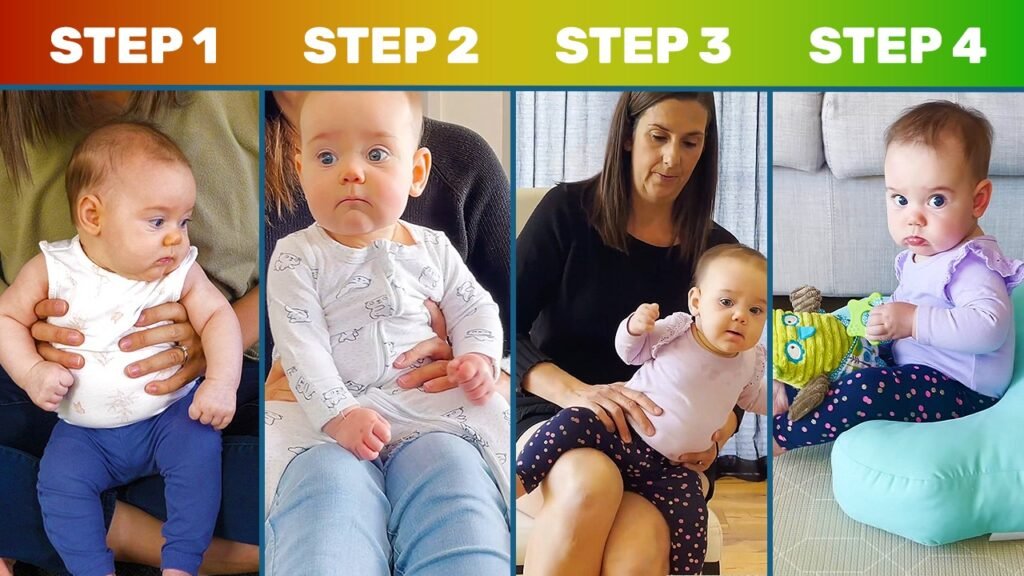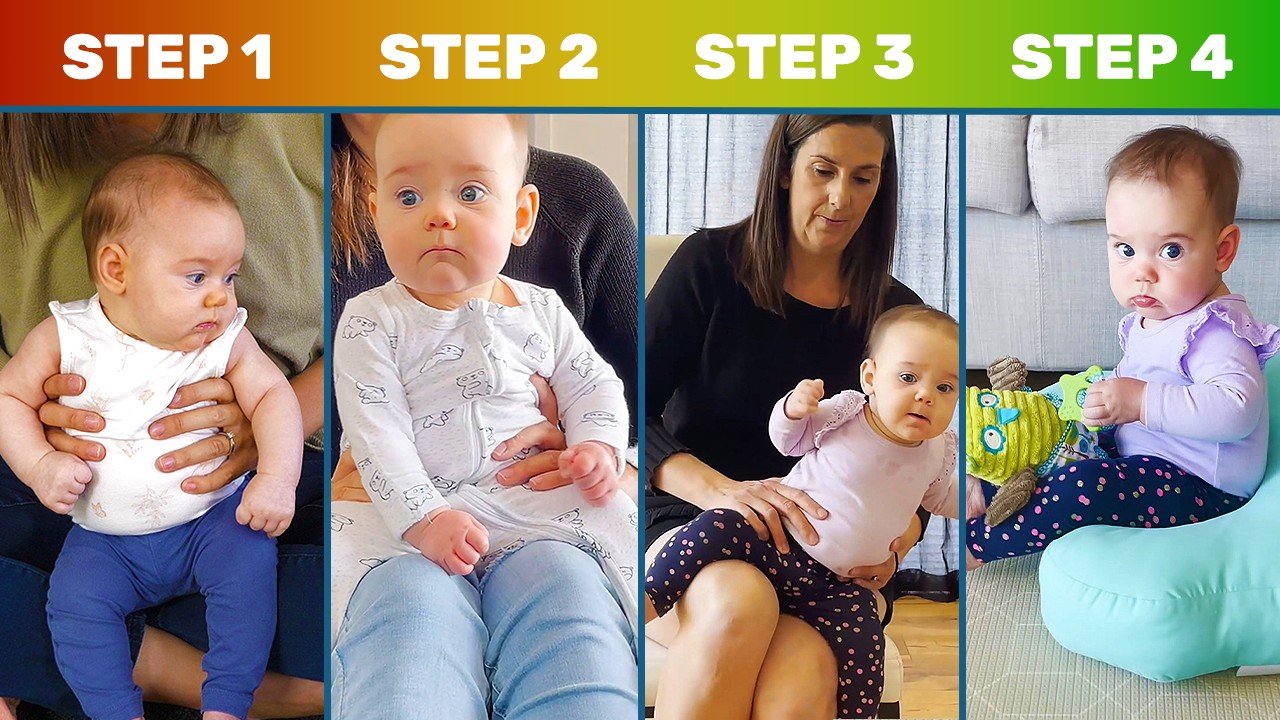In the video “Reduce Support Gradually for Independent Sitting,” Emma Hubbard provides four easy steps to teach your baby to sit up independently. She explains that assisted sitting is the first step, which can be done on your lap or on the floor with support around the rib cage. As your baby becomes stronger and more confident, you gradually reduce support and introduce dynamic sitting activities to strengthen core muscles and improve balance. To ensure safety during the learning process, it is recommended to use a soft landing area, like a nursing or boppy pillow. Baby floor seats may hinder gross motor development and pose safety risks. By following these steps, you can help your baby develop the skills and strength needed to sit up independently in no time!
Once your baby can hold their head up on their own, it’s time to help them learn to sit. Gone are the days where your baby just lays quietly in your arms; now, they want to sit up and look around. In the video, Emma Hubbard guides you through four main steps to teach your baby to sit up independently. Starting with assisted sitting, you gradually reduce support and introduce dynamic sitting activities to strengthen their core muscles and improve balance. By following along with each step, you can help your little one develop the necessary skills and enjoy their newfound independence!
Steps to Teach Babies to Sit Up Independently
Teaching your baby to sit up independently is an important milestone in their development. Not only does it give them the opportunity to explore their surroundings from a different perspective, but it also helps strengthen their core muscles and improve their balance. In this article, we will outline the steps to teach babies to sit up independently, starting from assisted sitting all the way to ensuring safety during the learning process.

Assisted Sitting
The first step in teaching your baby to sit up independently is assisted sitting. This can be done on your lap or on the floor with support around the rib cage. By supporting your baby in a seated position, you are providing them with the necessary stability to focus on controlling their upper body.
Supporting the Baby on Your Lap
To support your baby on your lap, sit on a chair or on the floor with your legs crossed. Place your baby in a sitting position on your lap, facing outward. Use your hands to support the baby’s back, gently holding them in an upright position. This will help them maintain their balance and gradually develop the muscles needed for independent sitting.
Providing Support around the Rib Cage
Another method of assisted sitting is providing support around the baby’s rib cage. Place your hands around the baby’s rib cage, applying gentle pressure to provide support. This will help keep their lower body steady, allowing them to focus on controlling their upper body. Monitor the baby’s comfort and stability throughout the process, adjusting your support as needed.
Using a Soft Landing Area
When practicing assisted sitting, it’s essential to create a safe environment. Using nursing or boppy pillows as a soft landing area can help reduce the risk of injury during falls. Place the pillows around the baby to cushion their landing if they lose their balance. This will not only ensure their safety but also provide them with a comfortable and secure environment to learn.
Gradually Reducing Support
Once your baby has gained some stability and strength from assisted sitting, the next step is gradually reducing support. This step involves transitioning support from the rib cage to the middle of the trunk and eventually around the hips.
Transitioning Support from the Rib Cage to the Middle of the Trunk
As your baby becomes stronger at sitting, you can start moving your hands from supporting the rib cage to the middle of their trunk. This shift in support requires the baby to control more of their body to stay seated, further improving their muscle strength and sitting balance. Gradually reduce the support by lowering your hands down their body, but be sure to do it gradually to avoid overwhelming or destabilizing the baby.
Eventually Providing Support around the Hips
Once your baby can sit with support just around their hips, it’s a sign that they are getting closer to independent sitting. Encourage them to use their own muscles to keep themselves upright. By this point, you should be providing minimal support or none at all, allowing the baby to rely on their own strength.
Introducing Dynamic Sitting Activities
To strengthen their core muscles and improve their balance, it’s essential to introduce dynamic sitting activities to your baby’s routine. These activities involve small movements and encourage the baby to engage and use their muscles while sitting.
Tilting the Baby Side to Side
One way to practice dynamic sitting is by tilting the baby side to side. Sit on the floor or an exercise ball with your legs extended. Place your hands on the baby’s hips and gently lean them to one side. Observe how the baby actively works against the lean, aligning their head with their body and attempting to sit back up. If they struggle, gently assist them in coming back up and gradually move to tilting them to the opposite side. This activity helps strengthen their core muscles and improve their sitting balance.
Using a Toy to Encourage Movement and Balance
Another way to practice dynamic sitting is by using a toy to motivate your baby to move and balance. Sit on the floor with your legs extended and place your baby between them. Support the baby’s hips with your hands and hold a toy in front of them or slightly out of their reach. Encourage them to lean forward to grab the toy, and as they do, they will naturally try to sit back up. Depending on their strength, they may be able to do this independently or require your assistance. This activity helps develop their motor skills and further boosts their confidence in sitting independently.
Encouraging Independent Sitting
As your baby becomes stronger and more confident in their sitting abilities, it’s important to continue encouraging their independence. This involves strengthening their core muscles, boosting their confidence, and gradually reducing support.
Strengthening Core Muscles
To strengthen your baby’s core muscles, continue practicing assisted sitting, gradually reducing support, and incorporating dynamic sitting activities into their routine. These activities engage their muscles and help them develop the necessary strength to sit independently.
Boosting Baby’s Confidence
As the baby gains more control over their sitting position, it’s crucial to boost their confidence. Offer praise and encouragement whenever they make progress, and provide them with opportunities to practice sitting independently in a safe and supportive environment. This positive reinforcement will motivate them to continue developing their skills.
Gradually Reducing Support
As your baby’s confidence and strength grow, it’s time to gradually reduce support. Transition from providing support around the hips to giving minimal assistance or none at all. Be patient and give them time to practice sitting independently. If they struggle or lose their balance, offer a helping hand, but encourage them to do as much as they can on their own.
Ensuring Safety During the Learning Process
While teaching your baby to sit up independently, it’s crucial to prioritize their safety. Create a safe and supportive environment to minimize the risk of injury and address any potential safety risks.
Using a Soft Landing Area like a Nursing or Boppy Pillow
Using a soft landing area, such as a nursing or boppy pillow, can significantly reduce the risk of injury during falls. Place the pillow behind the baby’s back to cushion their landing if they lose their balance. This provides them with a sense of safety and encourages them to explore their sitting abilities without fear of hurting themselves.
Avoiding the Use of Baby Floor Seats
While baby floor seats may seem convenient, they can hinder gross motor development and pose safety risks. These seats provide excessive support, restricting the baby’s movement and the opportunity to strengthen their muscles. It’s best to opt for natural sitting positions and gradually reduce support instead.
Addressing Safety Risks
Regularly assess the surroundings to identify and address any safety risks. Remove any objects or obstacles that could pose a danger to the baby, and ensure that the area is free from hazards. Supervise the baby closely during the learning process and be ready to offer support or adjust the environment as needed to ensure their safety.
Conclusion
Teaching your baby to sit up independently is an exciting and important milestone in their development. By following the steps outlined in this article, starting from assisted sitting and gradually reducing support to introducing dynamic sitting activities and ensuring safety, you can help your baby develop their core muscles and balance while fostering their independence. Remember to create a safe and supportive environment, provide praise and encouragement, and be patient as your baby progresses in their journey to independent sitting.

